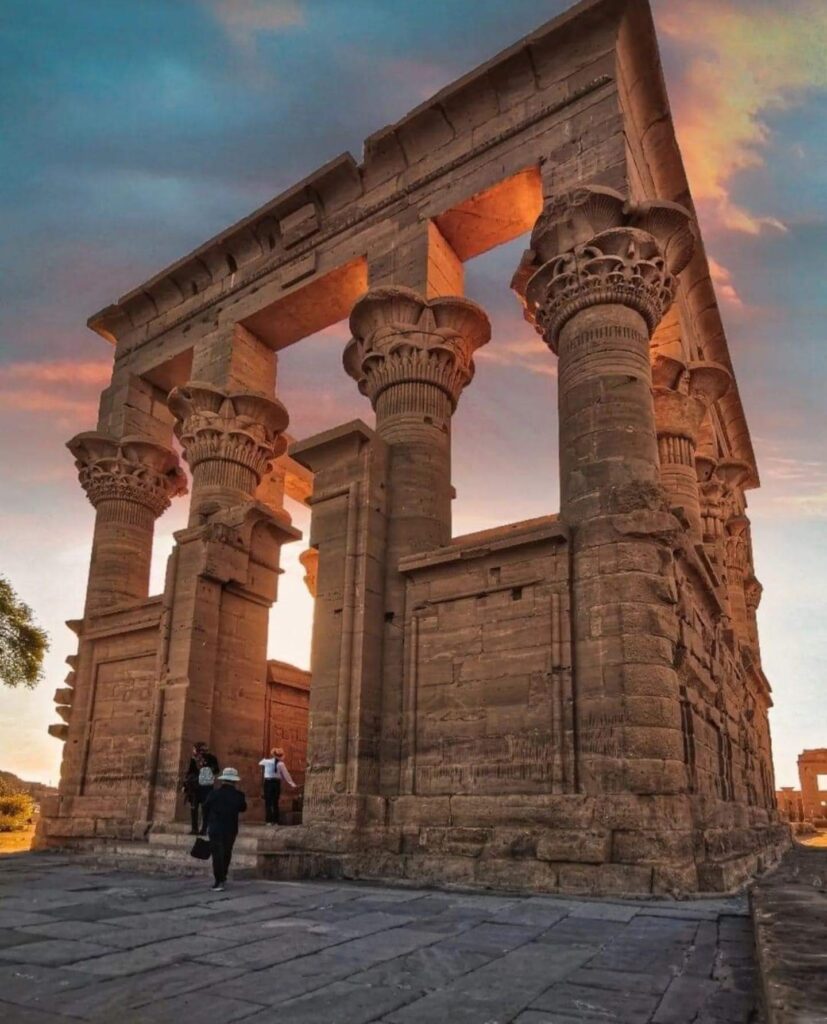The Kiosk of Trajan, commonly called Pharaoh’s Bed, is one of Egypt’s most picturesque monuments, located on Agilkia Island. Once part of the Philae temple complex, this iconic structure is a masterpiece of ancient design and a testament to Egypt’s architectural brilliance. Its relocation to Agilkia Island in the mid-20th century saved it from submersion due to the construction of the Aswan High Dam, ensuring its survival for future generations.
Historical Context and Purpose
Built During Roman Rule
The Kiosk was constructed during the reign of Roman Emperor Trajan (98–117 AD). While Egypt was under Roman control, the emperors recognized the significance of aligning with local religious traditions to secure their rule. The structure was dedicated to the goddess Isis, one of ancient Egypt’s most revered deities. It served as a ceremonial pavilion, likely used as a waystation for travelers arriving by boat to the sacred island of Philae.
Fusion of Cultures
The Kiosk reflects the fusion of Egyptian and Greco-Roman styles. While its purpose was rooted in Egyptian religious practices, the design incorporated Roman influences, showcasing how Egypt adapted to foreign rulers while maintaining its cultural identity.

Architectural Marvel
Design and Features
The Kiosk of Trajan is an open, roofless pavilion, rectangular in layout, with 14 slender columns that form a colonnade around its perimeter. Each column is crowned with intricately carved floral capitals, a hallmark of Egyptian temple design. These capitals, combined with the overall proportions, lend the structure an air of elegance and lightness.
The columns support architraves carved with vivid reliefs that depict Emperor Trajan presenting offerings to Egyptian gods such as Isis, Hathor, and Osiris. This artistic blending of Roman imperial imagery with Egyptian religious iconography reflects the cross-cultural exchange of the time.
Symbolism of the Roofless Design
Unlike other Egyptian temples that were enclosed and dark, the Kiosk was open to the sky, symbolizing the connection between the earthly and divine realms. This openness may also have represented the welcoming nature of the temple, as it marked the entryway for visitors arriving by boat to Philae.

Relocation to Agilkia Island
In the 20th century, the construction of the Aswan High Dam posed a threat to many ancient sites, including Philae. Rising Nile waters would have submerged the temples, leading to an unprecedented international effort led by UNESCO. Between 1972 and 1980, the temples of Philae, including the Kiosk of Trajan, were carefully dismantled and relocated to the nearby, higher-ground Agilkia Island.
This meticulous project not only saved the Kiosk but also highlighted the global commitment to preserving cultural heritage. Today, visitors can admire the Kiosk in a setting designed to replicate its original environment as closely as possible.
Cultural and Historical Significance
Symbol of Endurance
The Kiosk of Trajan is more than a relic of the past; it symbolizes Egypt’s ability to adapt and preserve its cultural identity through centuries of foreign rule and modern challenges. Its intricate carvings and harmonious design continue to awe visitors, serving as a bridge between Egypt’s ancient traditions and its interaction with the wider world.
Inspiration for Modern Conservation Efforts
The successful relocation of the Kiosk and other monuments on Philae set a precedent for large-scale heritage preservation projects worldwide. It stands as a reminder of the importance of safeguarding humanity’s shared history.

Conclusion
The Kiosk of Trajan, or Pharaoh’s Bed, is a testament to the ingenuity and cultural depth of ancient Egypt. Blending Egyptian and Roman elements, it offers a glimpse into a pivotal era of historical transition. Thanks to international conservation efforts, this architectural jewel continues to inspire admiration and wonder, standing as a timeless symbol of Egypt’s enduring legacy. Whether viewed as an artistic marvel, a sacred space, or a cultural bridge, the Kiosk of Trajan remains a true treasure of the ancient world.
